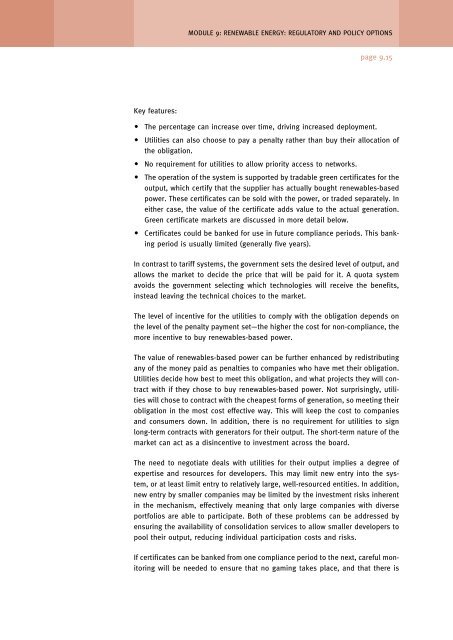Regulatory and policy options to encourage development of ...
Regulatory and policy options to encourage development of ...
Regulatory and policy options to encourage development of ...
- No tags were found...
You also want an ePaper? Increase the reach of your titles
YUMPU automatically turns print PDFs into web optimized ePapers that Google loves.
MODULE 9: RENEWABLE ENERGY: REGULATORY AND POLICY OPTIONSpage 9.15Key features: The percentage can increase over time, driving increased deployment. Utilities can also choose <strong>to</strong> pay a penalty rather than buy their allocation <strong>of</strong>the obligation. No requirement for utilities <strong>to</strong> allow priority access <strong>to</strong> networks. The operation <strong>of</strong> the system is supported by tradable green certificates for theoutput, which certify that the supplier has actually bought renewables-basedpower. These certificates can be sold with the power, or traded separately. Ineither case, the value <strong>of</strong> the certificate adds value <strong>to</strong> the actual generation.Green certificate markets are discussed in more detail below. Certificates could be banked for use in future compliance periods. This bankingperiod is usually limited (generally five years).In contrast <strong>to</strong> tariff systems, the government sets the desired level <strong>of</strong> output, <strong>and</strong>allows the market <strong>to</strong> decide the price that will be paid for it. A quota systemavoids the government selecting which technologies will receive the benefits,instead leaving the technical choices <strong>to</strong> the market.The level <strong>of</strong> incentive for the utilities <strong>to</strong> comply with the obligation depends onthe level <strong>of</strong> the penalty payment set—the higher the cost for non-compliance, themore incentive <strong>to</strong> buy renewables-based power.The value <strong>of</strong> renewables-based power can be further enhanced by redistributingany <strong>of</strong> the money paid as penalties <strong>to</strong> companies who have met their obligation.Utilities decide how best <strong>to</strong> meet this obligation, <strong>and</strong> what projects they will contractwith if they chose <strong>to</strong> buy renewables-based power. Not surprisingly, utilitieswill chose <strong>to</strong> contract with the cheapest forms <strong>of</strong> generation, so meeting theirobligation in the most cost effective way. This will keep the cost <strong>to</strong> companies<strong>and</strong> consumers down. In addition, there is no requirement for utilities <strong>to</strong> signlong-term contracts with genera<strong>to</strong>rs for their output. The short-term nature <strong>of</strong> themarket can act as a disincentive <strong>to</strong> investment across the board.The need <strong>to</strong> negotiate deals with utilities for their output implies a degree <strong>of</strong>expertise <strong>and</strong> resources for developers. This may limit new entry in<strong>to</strong> the system,or at least limit entry <strong>to</strong> relatively large, well-resourced entities. In addition,new entry by smaller companies may be limited by the investment risks inherentin the mechanism, effectively meaning that only large companies with diverseportfolios are able <strong>to</strong> participate. Both <strong>of</strong> these problems can be addressed byensuring the availability <strong>of</strong> consolidation services <strong>to</strong> allow smaller developers <strong>to</strong>pool their output, reducing individual participation costs <strong>and</strong> risks.If certificates can be banked from one compliance period <strong>to</strong> the next, careful moni<strong>to</strong>ringwill be needed <strong>to</strong> ensure that no gaming takes place, <strong>and</strong> that there is










